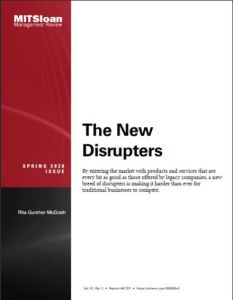Join getAbstract to access the summary!

Join getAbstract to access the summary!
Rita Gunther McGrath
The New Disrupters
By entering the market with products and services that are every bit as good as those offered by legacy companies, a new breed of disrupters is making it harder than ever for traditional businesses to compete.
MIT Sloan Management Review, 2020
What's inside?
Digital start-ups speed up the pace of competition.
Recommendation
Today’s disruptive start-up companies take advantage of digital technologies to offer quality products at lower costs. Using digital platforms to market directly to consumers, these newcomers bring their products to market quickly and put pressure on legacy companies more rapidly than in the past. Consumers, for their part, appreciate the easy access, convenience, 24/7 support and favorable return policies. Rita Gunther McGrath, a professor of management at Columbia Business School, urges traditional companies to understand and adopt the practices of the digital competition.
Summary
About the Author
Rita Gunther McGrath is a professor at Columbia Business School and an expert on strategy, management and innovation in uncertain and volatile environments.

















Comment on this summary